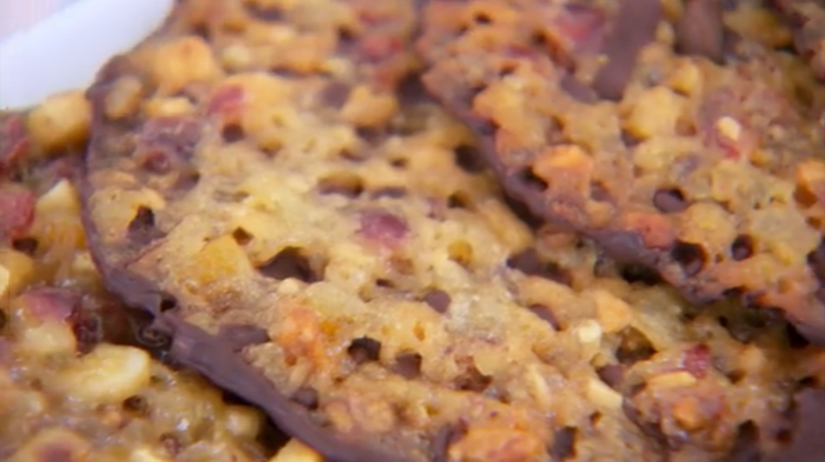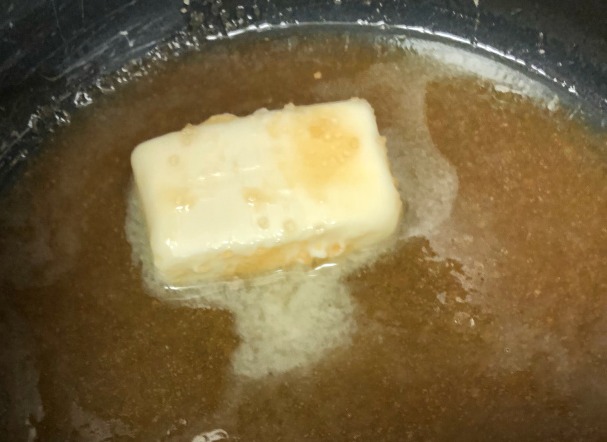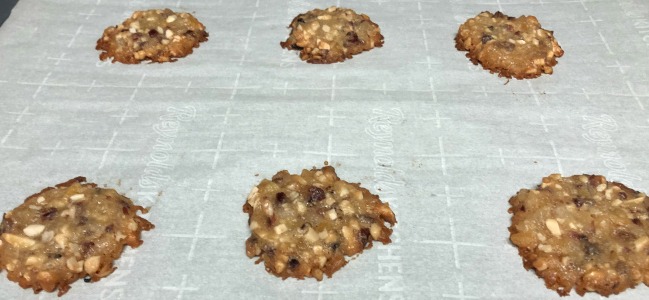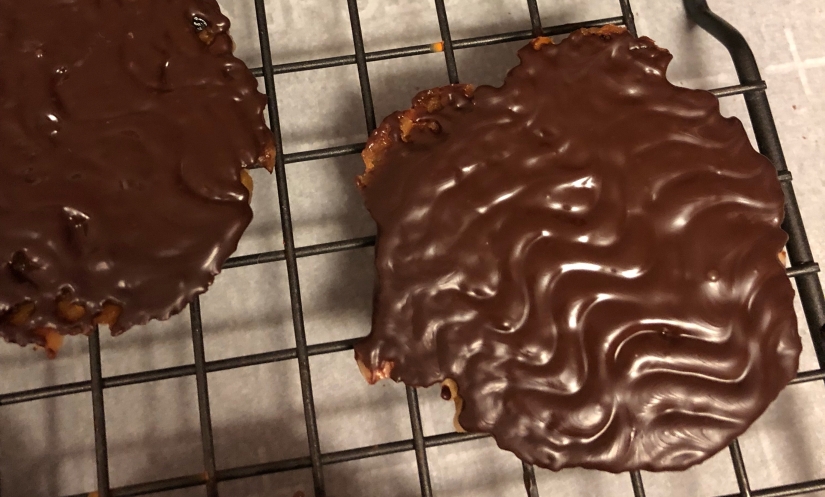Biscuits vs. Cookies – A Crispy Dilemma

I’ve got one successful #GBBO technical bake under my belt, and I figure I’ve got number two in the bag, because Week 2 of Series 5 (American Season 1) is Biscuit Week. What is more unassuming than a biscuit? They are a snack, for goodness sake. They’re eaten in the afternoon dipped in tea, or they’re thrown in lunch-boxes, or displayed in a pile on a plate at a party. Why should I be intimidated by a thing that is served in a pile?
In the dark times, before I had ever watched The Great British Bake Off, I was under the false impression that the American term “cookie” and the British term “biscuit” were synonymous, but that is not exactly true. My favorite way to eat a cookie is molten. I like my cookies grossly oversized and so fresh out of the oven that the roof of my mouth is in peril. When you pierce the outside of the cookie, the buttery, hot dough should ooze out and the chocolate chips should just flow. It has to be served with a spoon and a scoop of vanilla ice cream otherwise you’d be a mess. The queen would not call that a biscuit. British people would call an Oreo a “biscuit,” and they would call a gooey chocolate chip cookie a “cookie,” and I have no idea what they would call the 400 degree monstrosity I’ve described above, but I’m sure it would sound vaguely sexual. Maybe ‘self-saucing pudd’ of ‘banging whiffle.’
The word ‘biscuit’ comes from the Latin ‘bis’ meaning ‘twice’ and ‘coctus’ meaning baked (Man, I sure can Google!). The British biscuit is generally to be dry, and, above all else, crisp. Crisp, crisp! I don’t think there is a word that Mary Berry loves more. I can hear her saying it even now in my head. She really bites into that word, getting all of the onomatopoetic goodness out of it. The word ‘cookie,’ if you’re curious, comes from the Dutch word ‘koekje’ meaning ‘little cake‘ and should be, above all else, in my belly.

The Brief

Once Mel and Sue kicked Paul Hollywood and Mary Berry, in a smashing white motorcycle jacket (“See you later, Pussy!” – Mel), out of the tent, the bakers eagerly awaited the announcement of what delicious, crispy biscuit they’d be muddling through for their Technical Challenge. The announcement of “eighteen Florentines” to be made in 1 and 1/4 hours sent the challengees into a nervous titter. Sue didn’t go into describing what, exactly, a Florentine was, but the contestants seemed to know and were wary. Norman, our elder seaman, said he had never baked them because he hadn’t baked much “fancy stuff.” What? Fancy cookies… er, biscuits?

Mary Berry describes the pitfalls of the fancy Italian Florentine to Paul Hollywood in the privacy of their cozy judge’s tent. “They should have a sort of lacy appearance, be delicate.” They’re a caramel biscuit chock full of chopped nuts and fruit and the underside is smothered in tempered chocolate. “If they got the chocolate at the right temperature, it doesn’t leak through.”
I took down the recipe, along with plenty of notes, from the Great British Master Class, Series 1: Episode One, as Ms. Berry made this crispy confection from top to chocolaty, well-tempered bottom.
The Shopping List
While I already had most of the tools needed and many of the ingredients I either had on hand or could get from the neighborhood grocery story, there were a few items I had to hit up the World Wide Web for.
- A pastry brush. I have bought pastry brushes before, but after using them once or twice I tend to distrust their cleanliness (Neurotic much? Yes. All the time.). I found these silicon pastry brushes from Adept Chef on Amazon, and the fact that they have these fat, dishwasher safe “bristles” is very comforting.
- An instant read thermometer. This was probably my favorite purchase for this bake. I know, what could be more exciting the sanitary pastry brushes? I’ve never done sugar work or properly tempered chocolate. I’ve done the thing where you zap grated chocolate in the microwave in 30 second bursts so you don’t spoil a chocolate’s temper to coat things, but having an actual thermometer feels much more scientific and official. Hopefully I’ll end up with nice, shiny brown bottoms! Here’s the thermometer I purchased.
- Demerara Sugar. In the Masterclass, Queen Mary said she uses Demerara sugar because it “gives a little bit of crunch.” It smells caramel-y, molasses-y like brown sugar but it’s granulated with these large, tawny granules. I purchased India Tree brand Demerara sugar.
- Golden Syrup. Golden syrup, which can also go by the much less sexy name ‘light treacle,’ is a syrup made from cane sugar that originated in Plaistow, England. I purchased Lyle’s Golden Syrup, which I would love to say was because it was the original golden syrup, but it was literally the first hit.
- A Mixed Peel Mix Up. I had a mixed peel related snafu. I couldn’t find anything on Amazon that was specifically “mixed peel.” I looked on just the “regular internet” and I found this, which is on a site that delivers British products world wide, but I wouldn’t get it in time for my tight, self-imposed, and entirely arbitrary blog schedule. So I ordered diced peel in orange and lemon and they came in a tub with syrup, not unlike the glacé cherries from the Cherry Cake. The more I thought about it, though, they did not look like the product from the masterclass episode. Merry Berry didn’t mention rinsing syrup off of anything, and the actual pieces looked way to big for a thin, delicate biscuit. I finally broke down and googled the damn recipe, and what is actually called for is candied mixed peel, which is a different thing entirely. I ended up buying candied peel in orange and lemon. I’m relieved to have the correct ingredient, but now Brad and I are just swimming in superfluous peel. If you have suggestions for all of this extra peel we have lying around, syruped or candied, I am open.
On Your Mark, Get Set… Bake!

Going slightly nuts… and peel and cranberries. First things first, I’ve got to prep all of my ingredients. Jordan was slightly stressed by the whole ordeal as he chopped his nuts one at a time, “This is Mary Berry’s recipe, and we do not want to upset Ms. Mary Berry.” The brave bakers furrowed their brows over how finely to chop the fruit and nuts. I didn’t break a sweat, however, because not only do I know what the end product is supposed to look like, but I bought my walnuts pre-chopped. GASP! Shocking, I know. The whole integrity of this experiment of my making #GBBO technical bakes is dashed, but if it makes you feel any better, it did not give me that much of a time advantage at all. And I mean at all.

I weighed off all of my ingredients and then used the size of my pre-chopped walnuts (Gasp! Oh, stop.) as the basis of how finely I chopped everything else – the slivered almonds, candied peel, and cranberries. That is one of the many advantages of baking by weight, by the way. Whole or chopped, 50 g of dried cranberries is 50 g.
After that, I just added the 50 g of all-purpose flower to the bowl of chopped ingredients, because they were all going in at the same time anyway.
Buttery, caramel goodness. Being a devotee of Great British Bake Off, I’ve watched many batches of caramel go into the bin. Carmel making can seem like a temperamental endeavor, and the bakers take it very seriously. Nancy stirs her mixture of butter, sugar, and golden syrup on the stove constantly making sure it doesn’t go to a boil as the sugar dissolves. Turned out all she was accomplishing was burning some pre-cookie calories, because you’re not really making caramel at all. In the masterclass, M.B. recommends just melting the butter into the sugar and syrup over gentle heat just until the butter is melted and no more. I suppose this is to preserve some of the crunchiness of the Demerara sugar and the rest of the caramelization will happen in the oven. (Not that I speak ill of Nancy! She took 2nd place in this challenge, crunchy sugar or nay.)
I am not a huge fan of doing things on the stove. It just doesn’t feel very precise to me. If the recipe says to pre-heat the oven to 375°, I turn the knob and bing-bang-boom – it’s 375°. A recipe says to turn the stove on to a gentle heat, what is that? I just turned my stovetop to “3,” whatever that means, and kept an eye on the situation. The butter relaxed slowly into the sugar and syrup, and when there was just the slightest, sunny little knob of butter left, I pulled the pan off the heat and let the residual heat do the rest, just like Mary Berry had done in the masterclass.

Floren-eighteen biscuits? Once my butter was totally melted, I dumped all of my chopped ingredients and flour into the delicious, warm, buttery sugariness, and a few stirs in I was hit with the beautiful citrus fragrance of the candied peel. At that moment I knew, however my Florentines turned out, they would taste amazing. I tried a few small pieces of peel by themselves before I started baking, and they were mostly bitter and tasted of sugary pith (and no, I don’t have a lisp.). Not appetizing. But the heat and the caramel-y sugar unlocked their inner orangey potential.
Once all of the ingredients were together, it was time to split the mixture into 18, but looking at how much mixture you get, 18 sounds like a lot of biscuits from the batch. All the competitors’ instructions said was to spoon the mixture on to each of the trays, but the they knew that uniformity was one of their chief concerns. Richard tried to stay optimistic, “So, I am using a spoon, which is a good start, isn’t it?” In the masterclass, Mary Barry suggested more or less eyeballing it, but I decided to go the route of Nancy, Diana, and Chetna and bust out the scale again. I weighed all of my mixture add it was 310 g, and I divided by 18, which comes out to 17.2 g – that comes out to about 17 g per biscuit.
I carefully weighed off eighteen 17 gram caramel mounds of nutty goodness and spaced them evenly on three baking sheets.
Mis-bakes were made… Before I popped the first tray of my little Florentines-to-be into the 350° oven, I gave each of the six a little pat-pat to flatten them out, as I had seen M.B. do in her masterclass. I gave them the prescribed 8 to 10 minutes until the edges were slightly browned but when I took the biscuits out they were – I hate to say it – dinky. They were petit, small, bijou, infinitesimal. This would not do! Mary Barry was quite the size queen when it came to her Florentines. In judging, she pointed out – before God and the other bakers – that Iain had small Florentines and he was stoic about it but I’m sure he was devastated. They weren’t lacy either.

For the next batch, I gave each round a solid smoosh, so they were a quarter of an inch thick before sticking them in the oven. They came out slightly flatter and slightly lacier, but they still didn’t look like ones my hero, Mary Berry, made.
So for the third batch, I really gave those biscuit balls a pressing. I flattened those balls like they cheated on me with my sister. The third batch did turn out to be the best batch, but I was really baffled at why my Florentines were not as delicate and lacy as Mary Berry’s. It wasn’t until much later that it hit me. I forgot to factor that I was using a conventional oven, and not a Fan oven, so my oven was 25° too cold. (For clarification see the What the Fan??!! section of my Cherry Cake Post.) So the butter and sugar wasn’t getting hot enough to really bubble out and get really thin and lacy before it got brown and solid.
Watch your temper. With my minuscule, lace-less cookies cooling on racks, it was time to bust out my brand new thermometer and temper my chocolate. The recipe calls for 200 g of dark chocolate, and the two Ghirardelli 60% chocolate bars were each 113 g each. Some quick math will tell you that I ate about 26 g of dark chocolate, which made me feel a bit better in general. I chopped up the remaining chocolate and created a bain-marie, which is when you place a glass bowl over a pan of simmering water. This is the kind of professional technique you too can learn from watching way too much food television. Ms. B., in her masterclass, had some bon mots for the temperature at which to melt your chocolate: “Remember chocolate melts in a child’s pocket, so you don’t need intense heat underneath.” 100 g of the chopped chocolate went into the glass bowl, I turned the dial to “child’s pocket” and monitored closely with my hand-dandy thermometer. Richard said that he tempers his chocolate to 53°, Mary said that around 50° would do, so I split the difference and heated my chocolate to 51°.
I pulled the glass bowl off the simmering water and then slowly added the other 100 g of chocolate. Kate said that the slower you bring the temperature down, the shinier your chocolate, and with as small my pathetic Florentines were, I would need to see my face in it.

The classic zigzag. Well, the zigzag couldn’t have been all that classic, because our intrepid bakers were stumped. Nobody is better at being bewildered by a recipe than poor Jordan: “I’m racking my brain, what the hell does that look like?” Iain put his chocolate in a piping bag and did kind of a swizzle zigzag over the top, which looked cute BUT IT’S WRONG! Chetna, who generally has impeccable instincts, piped her zigzags on to the chocolate, which looked nice BUT IT’S WRONG! Martha, sweet, Martha was one of the lucky few who knew the forking secret.
Mary Berry recommended painting on the chocolate with a pastry brush to keep the chocolate from oozing through the lace. Because of my poor bake, that wasn’t really going to be an issue for me, but I had invested in those swanky silicone brushes. After applying the chocolate and letting it set for a few seconds, I dragged a fork through the chocolate in a tight zigzag. The pattern didn’t really show up right away, but when the chocolate hardened there it was – classic!

Did I make time? Hell no! Total whiff on that front. I was putting chocolate on my fourth biscuit when my one hour fifteen minute timer went off. Crushing. I’m sure if I were to have a second go at it, I could do it under that time – if I can add the 33% extra baking time for my stupid conventional oven.
The Gingham Altar

I don’t have Paul “Lazar Eyes” Hollywood and Mary “Tough Biscuits” Berry shaking down my Florentines. I just have the members of my Graphic Novel Book Club (The Ultimate Justice League of Extraordinary Graphic Novel Book Club) to try my wares.
Would it make the cut? Let’s start with the positives, shall we? They tasted really good. The brown-sugar sweetness paired with the bitterness of the chocolate, all wrapped in a citrusy bow was delightful. The nuts added crunch and the cranberries added tartness. They were definitely not burned, so if you closed your eyes it was a fancy biscuit. Also, my classic zigzags turned out pretty great on about two thirds of my batch.

Now for the negatives. Florentines are on their face, not an attractive biscuit, but mine are even less so. They look like the kind of thing your elderly cat would leave on the carpet. Not. Pretty. Mine are also wildly irregular in size from first batch to third. None of my biscuits are thin enough, so they’re would not get a crunchy “crisp!” from Mary Berry. But at least I didn’t take a cutter to them like Enwezor, right?

Richard took top prize on this technical bake, and Mary was practically beaming as she praised his near perfect Florentines, “Well done, Richard! They are the proper size, they were lacy, crisp, and that’s how they should be.” I would not have Ms. Berry singing odes to my biscuits. I would probably be down with the other Florentine failures, like Iain who’s biscuits were minute, over-baked and had no zigzags on the bottom and Norman who had chocolate bleeding all the way through. I’m going to tentatively put myself between Norman, number 10, and Iain, number 11, because, while my biscuits were all different sizes, they were not over-baked and I did have the proper decoration on the bottom.
So, not a good round. I would probably be on the chopping block for my sub-par Florentines, but lucky for me, this is all hypothetical! So, hypothetically I’d really pull it out in the Showstopper and live to see another bake. I would beat out Richard’s pirate scene made entirely out of gingerbread, complete with entwined sea monster, by making Dante’s Nine Circles of Hell, demons and all, entirely out of tuiles. Paul Hollywood would just drop to his knees and just openly weep at the sight of it and Mary Berry would kiss me square on the mouth… with tongue.

My humble Florentines were a huge hit at book club, by the way. There were no leftovers and they only had good things to say about my humble cookies, served on a plate in a pile. Isn’t having friends the best?
I included the temperature and times for conventional ovens so you can avoid my pitfalls and you can hypothetically win this Technical Challenge.
The Recipe: Mary Berry’s Florentines
50 g of Butter
50 g of Demerara Sugar
50 g of Golden Syrup
50 g of Plain Flour
50 g of Candied Mixed Peel (25 g of Lemon Peel and 25 g of Orange Peel)
25 g of Finely Chopped Almonds
25 g of Chopped Walnuts
25 g of Finely Chopped Dried Cranberries
200 g of Dark Chocolate
- Preheat your oven and prep your trays. Preheat your oven to 160° C Fan (350° F Fan, or 375° in a conventional oven) Cover three baking sheets in parchment paper.
- Make the caramel sauce. In a saucepan, put your butter, Demerara sugar, and golden syrup. Heat gently, stirring constantly, until the butter is just melted.
- Add your fruit and nuts. Add your flour, peel, almonds, walnuts, and cranberries to your caramel sauce and then stir until the fruit and nuts are coated and everything is a uniform caramel color.
- Divide into eighteen and flatten. Divide the mixture into 18 scoops, well spaced on three trays with 6 cookies per tray. Flatten the scoops so they are like caramel coins.
- Bake and cool. Bake in the oven for 8-10 (10-14 conventional oven) minutes until the have spread thin and gotten lightly brown around the edges. Cool on the pan until the cookies have hardened enough to transfer to a cooling rack.
- Temper your chocolate. While your cookies cool, finely chop your chocolate. Melt half of the chocolate in a bain-marie until it reaches a temperature of around 50°. Remove your chocolate from the heat, then gradually stir in the other half of your chocolate.
- Coat and decorate. Coat the underside of your cookie with chocolate using a pastry brush, then use a fork to draw the classic zigzag pattern. Give the cookies 5 minutes to set.




Hello me dear, I remember Demerara Sugar being served in all the restaurants over the pond, and only used for puting in our coffee. My mother had Golden Syrup as a staple in her pantry. She would make steamed puddings occasionally, and this was used like we would Log Cabin over here. Enjoyed the process and would certainly enjoy making these. From yer mum-in-law – aka Denise 🙂
LikeLiked by 1 person
I am digging the Demerara sugar. I just used it on the top of some muffins and they created a nice, golden crisp! If you have any suggestions of what to do with the rest of that golden syrup, lemme know. I for sure suggest giving the florentines a go – they are very yummy! Love, Lisa
LikeLike
I will have to put my thinking cap on. I also have a couple of British cookbooks I will have to hunt out for you.
LikeLiked by 1 person
Ooh! Thanks!
LikeLike